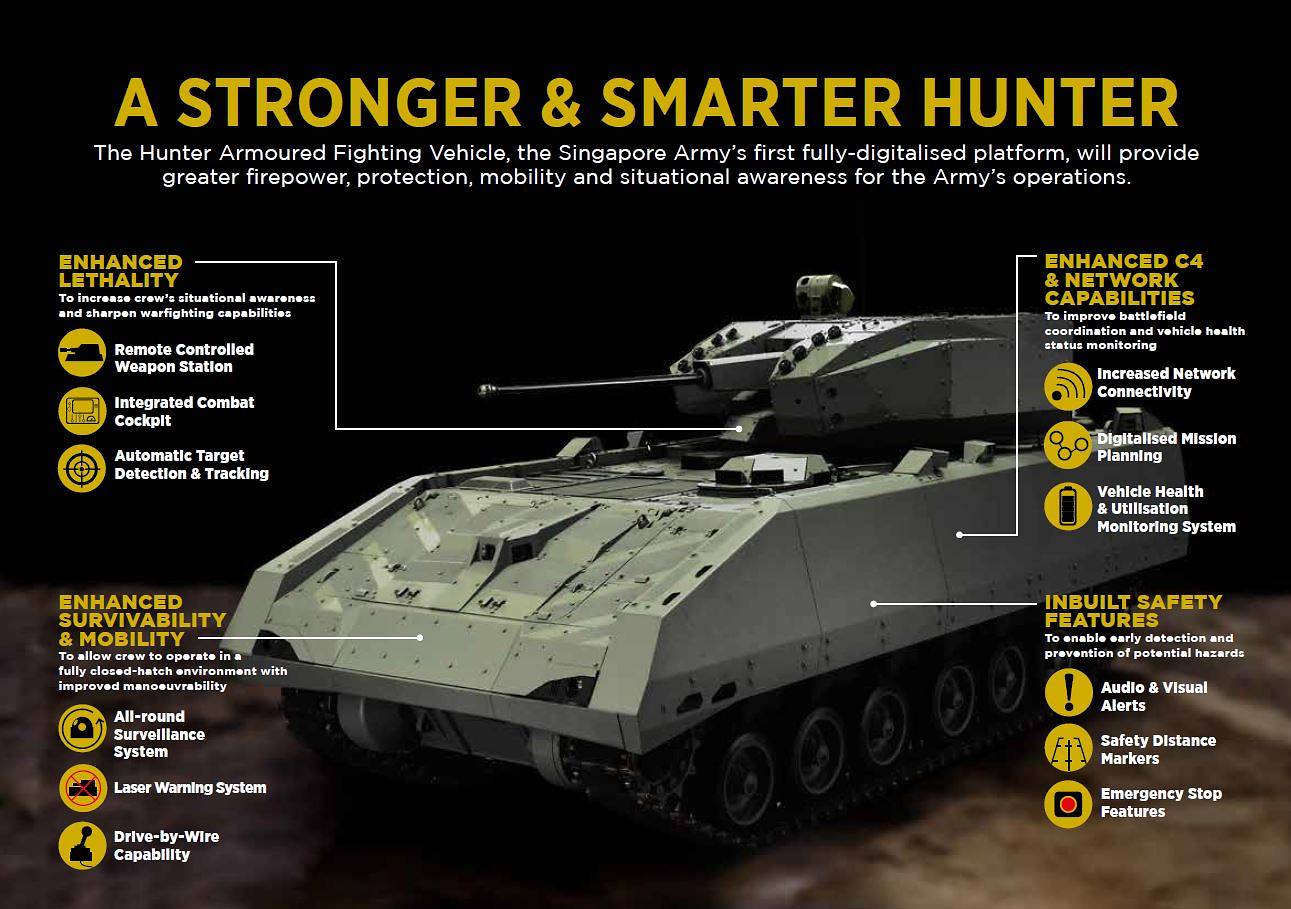SINGAPORE: The Singapore Armed Forces (SAF) on Tuesday (Jun 11) introduced the Army’s latest armoured asset – a next-generation vehicle that promises to be deadlier, faster, and safer than its predecessor.
The Singapore-made Hunter Armoured Fighting Vehicle (AFV) is the Army’s first fully digitalised platform and will replace the ageing Ultra M113, which has been in use since the 1970s.
The new vehicle, developed in a collaboration between the Defence Science and Technology Agency (DSTA), ST Engineering and the Singapore Army, will make its public debut at this year’s National Day Parade, said Defence Minister Ng Eng Hen on Tuesday.

Important features of the Hunter – the Singapore Army’s first fully-digitalised platform. (Graphic: MINDEF)
Speaking at the commissioning of the Hunter at the Armour Formation’s 50th anniversary parade at Sungei Gedong Camp, Dr Ng said the SAF places “considerable investment” in building up its Armour Formation.
“The Hunter replaces the Ultra M113 but represents a significant step up in all areas – better firepower, mobility and protection,” Dr Ng added.
“The Hunter fleet will require less manpower to operate, but with increased potency through the use of advanced technology.”
FASTER, BETTER, STRONGER
Armed with a 30mm cannon and anti-tank guided missiles, the Hunter features an automatic target detection and tracking system, improving the crew’s ability to detect and engage targets.
It is also the Army’s first AFV to be equipped with an integrated combat cockpit, which allows its commander and gunner to both operate the vehicle with a common set of controls.
The Hunter’s external cameras provides its crew with a 360-degree view of its surroundings.
The AFV comes with drive-by-wire capability, enabling the vehicle commander to take over the driving functions from the driver when necessary. In addition, the vehicle commander is also equipped with an independent sight, allowing him to detect other targets while the gunner is engaging a target.
To maximise crew protection, the Hunter is designed to be operated close-hatched, with a series of cameras on its exterior providing a 360-degree field of vision to its crew while in the vehicle. A Laser Warning System will alert the crew when they are being targeted by an enemy.
A SMART HUNTER
But more critical is the Hunter’s advanced suite of digital systems. The Hunter comes equipped with the Army Tactical Engagement and Information System (ARTEMIS), which will allow efficient wireless information exchange between various military formations and vehicles.
“The Hunter can also be integrated with unmanned platforms, including robots,” Dr Ng said.
“For example, the Hunter crew can mobilise unmanned aerial and ground vehicles (UAVs and UGVs) to gather reconnaissance and surveillance information remotely, with obvious advantages for stealth manoeuvres and its own protection.”
The Hunter boasts an advanced suite of digital systems.
As a digital platform, the Hunter is equipped with a Health and Utilisation Monitoring System (HUMS), which will help the crew maintain their vehicle.
The AFV also has several inbuilt safety features, such as audio and visual alerts to prompt the crew about vehicle anomalies, potential system failures as well as hazards during movement and when stationary.
There is an emergency stop, and safety distance markers embedded on the driving camera displays.
In the late 1990s, the Army’s first locally-made armoured vehicle, the Bionix, was developed to fight alongside the M113.
In 2008, ST Engineering substantially overhauled the Leopard 2 main battle tanks to develop the local Leopard 2SG variant.
“From time to time, even though the Hunter is born and bred locally, I expect the Hunter to make overseas ‘hunting expeditions’ to Australia and other training grounds,” said Dr Ng.





